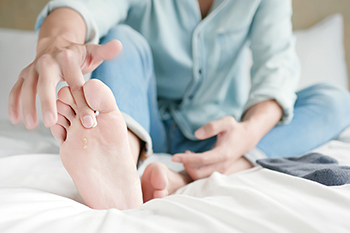
Fungal infections of the feet, including athlete’s foot and fungal toenail infections, often develop in warm, moist environments where fungi thrive. Fungal foot infections are more likely to occur when the feet are frequently damp from sweat, confined in enclosed shoes, or exposed to shared areas such as locker rooms, communal showers, and around swimming pools. Wearing synthetic socks and shoes that do not allow air circulation can also raise the risk. Additional risk factors include certain health conditions, like diabetes or circulation issues, as well as a weakened immune system. Athlete’s foot may cause itching, peeling, or flaking skin, especially between the toes, while fungal nail infections can lead to thickened, discolored, or brittle toenails. The infection may begin in one area and gradually spread across the foot or nails if left untreated. A podiatrist can help by providing a proper diagnosis and selecting the most effective treatment based on the severity of the infection. If you believe you have developed a fungal foot infection, it is suggested that you schedule an appointment with a podiatrist for appropriate treatment.
Athlete’s foot is an inconvenient condition that can be easily reduced with the proper treatment. If you have any concerns about your feet and ankles, contact one of our podiatrists from DM Foot & Ankle Associates . Our doctors will treat your foot and ankle needs.
Athlete’s Foot: The Sole Story
Athlete's foot, also known as tinea pedis, can be an extremely contagious foot infection. It is commonly contracted in public changing areas and bathrooms, dormitory style living quarters, around locker rooms and public swimming pools, or anywhere your feet often come into contact with other people.
Solutions to Combat Athlete’s Foot
- Hydrate your feet by using lotion
- Exfoliate
- Buff off nails
- Use of anti-fungal products
- Examine your feet and visit your doctor if any suspicious blisters or cuts develop
Athlete’s foot can cause many irritating symptoms such as dry and flaking skin, itching, and redness. Some more severe symptoms can include bleeding and cracked skin, intense itching and burning, and even pain when walking. In the worst cases, Athlete’s foot can cause blistering as well. Speak to your podiatrist for a better understanding of the different causes of Athlete’s foot, as well as help in determining which treatment options are best for you.
If you have any questions please feel free to contact our office located in Lemont, IL . We offer the newest diagnostic and treatment technologies for all your foot and ankle needs.